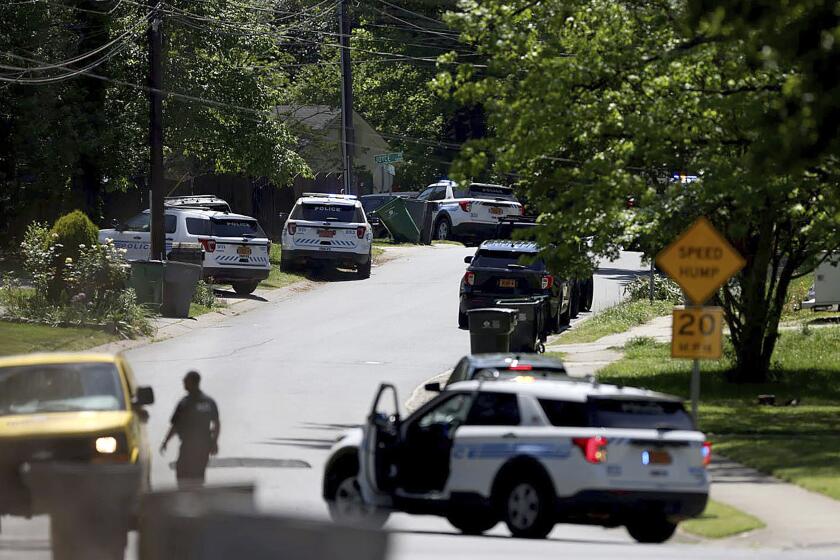Ghana workers bring cars back to life
Sometimes Alex Foley sits at home sifting through the pieces of a life-size puzzle in his mind: how to put that car back together.
Maybe it rolled three times or hugged a tree. Or the trunk is crushed like an accordion. Or the doors are “mumbled” from one end to the other.
Any mumble -- the local word for crash damage -- can be stretched, hammered, straightened, cut away, molded, welded, ground, filled and sprayed. Call it recycling, call it ingenuity. Even if the passengers couldn’t be saved, the car always can be.
“Whatever happens to the car, we’ll be able to do it,” says Foley, 50, a veteran “straightener.” “Any car that comes.”
The Odawna neighborhood where the motor repairmen work looks like a giant graveyard for cars, stretching as far as the eye can see. Ancient, crumpled autos -- lights smashed, paint rusted, bumpers falling off, tires flat -- are crammed together waiting for attention like a mob of patient cows.
Foley’s shop consists of a shed and a bunch of guys with hammers and chisels, some welding equipment and a couple of power tools. One glance at the hopelessly broken cars and the guys with hammers, and the whole venture looks wildly optimistic.
But the sprawling neighborhood of the Ghanaian capital, Accra, teems with industry and purpose.
Somewhere, a relentless tinny hammering rises. Shrieks of grinding metal shatter the air. A curlicue of acrid smoke spirals lazily as a worker melts a plastic Japanese bumper using a heated chisel, smoothing the surface as carefully as a mother frosting a birthday cake.
In the paint shop next to Foley’s shed, a worker painstakingly covers the windows and trim of a 20-year-old car with paper and tape. He has given the hood a shiny glaze of garish orange.
The oily floor of Sago Buckman’s workshop clings stickily at the sole. A mess of engines lies about, grown-up Lego pieces waiting to be used. A dingy backroom is piled high with unidentifiable pieces that to laymen’s eyes look like useless junk.
But to Buckman, a mechanic who takes the car after Foley has straightened it, nothing is ever useless junk.
That attitude, common across most of the continent, is born of poverty, but it defines African ingenuity. As much as hunger and disease, this waste-not, want-not approach marks the difference between Africa and America.
Buckman and his mechanic climb into a Japanese van under an unforgiving sun to work on the engine. Buckman drips with sweat, his brow furrowed in concentration. His trousers, an unlikely choice of off-white, are stained with oil.
Buckman is a reserved fellow who fiddles with his engine with quiet determination, saying little to the mechanic helping him.
Beneath the exertion, though, there’s exhilaration, creativity and pride in the car repair business here in Odawna. They’re daredevil surgeons willing to try any operation, while their Western counterparts resign themselves to prosaic nips and tucks.
“There’s no car we can’t fix,” says Buckman, 58, who’s been in the business 35 years and has trained so many apprentices he’s lost count. After fixing the damage he “sparks” the engine, or starts it up.
“I like the job. That’s the reason why I wake up early and come here to work on cars. When the engine gets spoiled, we dismantle it and fix it and put it together. When we spark it, I like that I have done a good job.
“It’s my work. I learned it. When you are interested to do it, you take it as your determined occupation. If you don’t like it, you won’t go there and learn to do it,” he says.
Buckman and Foley are neighbors who work as a team, each taking a cut. The job doesn’t pay a fortune, but it’s enough to put their children through school. Foley’s oldest son, 22, is studying architecture.
With his round face, permanent smile and protruding belly, Foley says he’s a happy man. Stumble into his yard and you find him lying next to a car with a welding torch in his hand. He leaps to his feet and drops everything to welcome a visitor.
“I really enjoy accident cars especially,” he says.
“Any time I go to my house, it plays on my mind and I work out the steps of how I’m going to work on the car. It’s like a puzzle. Sometimes we rack our brains.”
Foley throws open the hood of an ancient Fiat with the air of a magician. Voila! Inside, the motor has been removed and the entire front of the vehicle cut away and a new front welded on. Once the engine is back, no one will ever suspect, he grins.
The secret weapon in the car straightening business, he says, is a Come Along Winch, often used in Africa for logging. To stretch out a mumbled car, the straighteners use two ancient trees, chaining one end of the car to one tree and the winch to another. Then they attach the winch hook to the smashed area, and pull the car back into shape
“They pull it apart and it straightens up,” Foley says. The straighteners then pull out the engine and get to work.
“Then we go in there and use our hands and our other tools to make it nearly perfect.” The work is mainly done by hand using chisels and hammers.
Any panels that cannot be straightened are cut off. A new panel is welded in. If it’s not too complicated, the straighteners fashion a new one out of galvanized metal, using hammers and metal or wooden bars.
As a last resort, says Foley, there’s a shop in the nearby market that presses panels out of metal.
“Everybody has his role. Everybody has their own territory. I’m a top straightener. I can say I’m the best. But everybody has his own mind. Someone can challenge me and say they’re the best. But here on this plot, I’m the top.”
There’s not much point asking the straighteners of Odawna whether a car is still as safe as it once was after being straightened, or cut to pieces and welded. Safety is not the main preoccupation.
When Foley points his welding torch at the car, he has no eye protection. Ask him where his mask is and he grins sheepishly: “I’ll put it on in a minute,” he says with a shrug.
Rescuing totaled cars, tinkering and hammering and spraying shiny new coats onto old-model cars might seem crazy -- but the Western habit of writing off damaged cars is even more mystifying to Africans. It has to be explained to Foley a couple of times.
He crinkles his eyes, laughing in puzzled amusement. Perhaps, he ponders, Americans just don’t know how to repair broken cars.
“It’s a waste,” he says. “Here, we don’t waste anything.”
--
More to Read
Start your day right
Sign up for Essential California for news, features and recommendations from the L.A. Times and beyond in your inbox six days a week.
You may occasionally receive promotional content from the Los Angeles Times.






